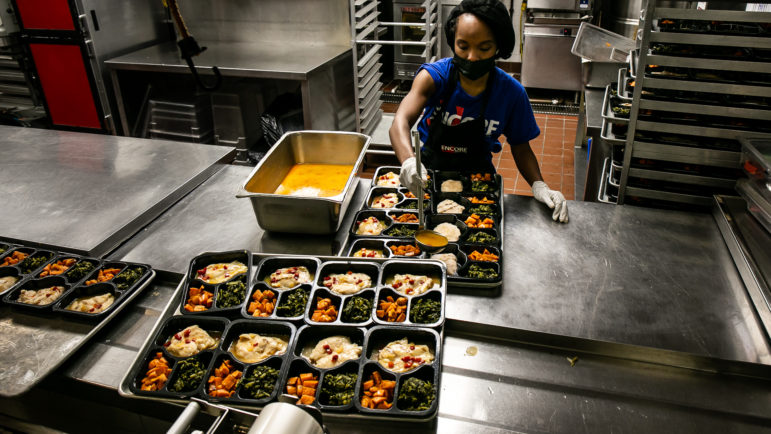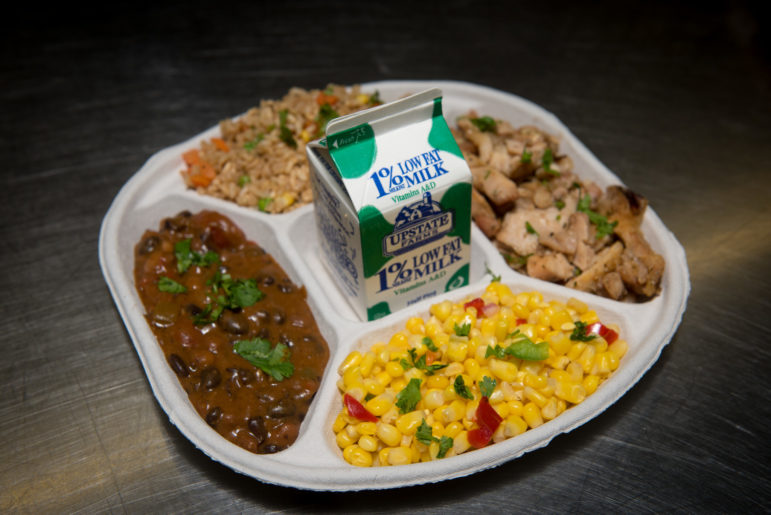New York City’s efforts to green its food system have been limited by a conflicting state law that says food must be procured by government entities based on cost alone. A bill being re-introduced in the upcoming legislative session in Albany would amend the existing law and allow every municipality in the state to opt into values-based procurement, factoring in other qualifications like nutrition and environmental sustainability when choosing food vendors.

Adi Talwar
Home delivery and grab-and-go meals being served and packed at Encore Community Services’ Senior Center.On a sunny day in February, Mayor Eric Adams stood at a podium outside Mercy Center, a community center and emergency food pantry in The Bronx, and signed Executive Order 8. That signature, which committed New York City to the Good Food Purchasing Program, was just one step in a years-long attempt to transform the city’s food system.
The Good Food Purchasing Program (which is just called Good Food Purchasing, or GFP, in New York) has been adopted by 24 cities across the country dedicated to “values-based procurement”—deviating from the standard practice of buying food from the lowest bidder, and opting instead to choose food providers that further one or more of the five goals of GFP. Under values-based procurement, the city can use the purchasing power of public institutions like schools and jails to support nutrition, local economies, workers rights, animal welfare, and environmental sustainability.
According to the United Nations, food and agriculture account for more than a third of greenhouse gas emissions globally. New York City’s public institutions—including schools, hospitals, senior care residences and correctional facilities—spend $500 million a year on food. The Department of Education (DOE) alone provides meals to more than 1 million children a day. The city’s pledge to the GFP model is intended to help reach its goal of reducing emissions associated with food by 25 percent by 2030, and to hit carbon neutrality by 2050.
But the city’s efforts to green its food system have been limited by a conflicting New York State law, General Municipal Law 103, that says food must be procured by government entities based on cost alone, which prevents the city from fully implementing values-based procurement. A bill is being re-introduced in the upcoming legislative session in Albany to change that.
“New York State procurement law hasn’t been updated since the 1970s, so it’s extremely outdated,” said Taylor Pate, the New York State Good Food Purchasing Program manager for Community Food Advocates. The legislation has been tweaked in recent decades with amendments such as a carve-out to promote local producers. But it remains true that, “New York has one of the most restrictive procurement laws in the country. Essentially, all contracts must be awarded to the lowest responsible bidder.”
To understand the potential impacts of full implementation of GFP, New York can look to its success on the other side of the country. The Los Angeles Food Policy Council developed the Good Food Purchasing Program in 2012 with input from over 100 stake-holders and experts. The LA Unified School District (LAUSD) is the second largest in the country after New York City, and serves 739,000 meals and snacks per day with an annual food budget of more than $150 million.
Within two years of implementing the program, the LAUSD had increased the share of locally-grown food from 25 percent to 50 percent, and of produce from 9 percent to 75 percent, according to the Food Service Director, David Binkle. Research from the National Farm to School network shows that one dollar spent on local foods adds between $1.60 and $3.12 to the local economy. This means that the $30 million spent on local food has a projected yearly benefit between $48 million and $94 million.
In order to hit their climate targets, LAUSD has focused on sourcing food from certified sustainable producers and shifting menus to reduce water use and carbon footprint. They reduced procurement of industrially produced meat—including beef, pork and poultry—by 28 percent, and of beef specifically by 35 percent, between 2013 and 2015. According to a report from the Union of Concerned Scientists, this is estimated to have reduced their annual carbon dioxide emissions by 9 million kilograms, about 22 percent, the equivalent to taking almost 2,000 cars off the road. It also saved about 14 gallons of water per meal, which adds up to annual savings of more than 1 billion gallons, or 1,760 Olympic swimming pools worth of water.
Other municipalities, including San Diego, Alameda County, Austin, Chicago, Cincinnati, Washington D.C. and Boston, have adopted the program. According to The Center for Good Food Purchasing, in the past six years, institutions in these areas have almost doubled their annual spending on foods produced by local, diverse, family and cooperatively-owned producers and processors, increasing from about 14 percent to 22 percent. Institutions have also shifted $4.3 million to producers that use minimal synthetic pesticides and fertilizers, avoid the use of hormones and antibiotics in their meat production, conserve water, regenerate soil, protect wildlife habitats, promote biodiversity, and reduce energy use, water consumption, and food waste.
But New York won’t be able to follow suit with the current state limitations. The Good Food New York Bill, introduced last year in Albany, would amend the existing law and allow every municipality in the state to opt into values-based procurement. It would also increase transparency around where food is sourced by requiring vendors to submit supply chain data that agencies would make publicly available. “That will make it even easier for institutions to make informed decisions about where they want to be purchasing from,” Pate said.
Community Food Advocates has been gathering a statewide coalition, which officially launched in October, in support of the bill reforming New York’s procurement law. This coalition includes the NRDC, CUNY Urban Food Policy Institute, The Center for Agricultural Development and Entrepreneurship (CADE), Alianza Agrícola and other organizations advocating for the environment, farmers and farm workers. Assembly Majority Leader Crystal Peoples-Stokes, Senator Michelle Hinchey and Senator Liz Krueger have been, “real champions of the bill,” said Pate. They also have over 30 co-sponsors throughout the Senate and the Assembly.

Michael Appleton/Mayoral Photography Office
“The bill had support last session, however, there were some key stakeholders—like the Farm Bureau—that we are still in conversation with to make sure the bill is in the best shape possible,” said Ribka Getachew, the campaign’s director for Community Food Advocates (the Farm Bureau did not return a request for comment for this story, but told the news site The River earlier this year that it wanted to ensure legislation prioritizes vendors within the state).
“With any paradigm shift,” said Getachew, “having advocates on the ground who recognize the value and the power of centering the perspectives of those that are closest to the problem is really impactful.”
But even if the Good Food New York Bill passes this year, there’s still a long road ahead to overhauling procurement. ”It’s taken us a good five years or so to get to where we’re at now,” said Craig Willingham, managing director of the CUNY Urban Food Policy Institute. “And I wouldn’t be surprised if it takes another five years for us to get to a full implementation.”
Procurement is a complicated process, especially on the scale of New York City. “There are a whole bunch of rules and regulations that govern how public procurement works,” said Fa-Tai Shieh, the director of food procurement at the Department of Citywide Administrative Services. “We need to be transparent, accountable, and we have to be able to justify the things that we buy with taxpayers dollars.”
Different agencies do their own purchasing, depending on their scale, and are beholden to different guidelines. For example, the DOE has extra hoops to jump through to comply with state and federal regulations around school meals.
There are two main procurement methods used in the city, competitive sealed bid and request for proposal (RFP). For the first, Shieh’s agency puts out a bid to all vendors with the criteria for what they need and vendors fill out the bid with their pricing. The agency then awards the bid to a vendor that has the best price while meeting the qualifications. RFP is a longer, more complicated process where vendors submit documentation to show they can fulfill criteria, and at what price.
The Good Food New York Bill will allow cities to factor qualifications other than cost into their procurement decisions, as long as the price is within 10 percent of the lowest bidder. “I think the thing that’s great about this bill is it gives municipalities the option to utilize values-based procurement in the way that really works best for them,” said Pate. “So the bill is not a mandate, it’s optional. So cities can choose which values they want to prioritize.”
The five goals of the city’s GFP initiative, developed in partnership with the Center for Good Food Purchasing, is measured via a points system that places values on specific qualifications. For example, an agency can receive points for purchasing food from purveyors who are Certified Humane, Fair Trade Certified, Pasture Raised, Animal Welfare Approved, USDA Organic, Byondimac or a number of other certifications. Additional points can be achieved if vendors offer vegetarian meals, list nutritional information, offer culturally appropriate options, switch to using only compostable dishware or if they phase out bottled water in favor of refillable jugs.
Craig Willingham says certain goals will be easier to achieve than others. “Nutrition and local economies tend to be the two categories that cities do well on,” he said. “Animal welfare and environmental sustainability are the ones they tend to not do so well on.”
Community Food Advocates has been working with city agencies directly to support them in maximizing what they can do within current legal constraints. “Local economies, nutrition— historically those have been the areas that have had the most movement and have the most inter-agency support that we’ve seen to date,” said Getachew.
The city has already made concerted efforts to improve these metrics through initiatives like the 2007 trans fat ban, the Farm to School program started in 2002, and New York Thursdays, launched in 2015, which incentivizes schools to have 50 percent of their lunch menus on Thursdays sourced from within the state. “I think that directly correlates with the higher scores in those value areas over the others,” Getachew said.
An assessment from 2019 showed that the DOE sourced 15.3 percent of food from local producers and that 85 percent of food fulfilled nutritional guidelines, which met GFP’s baseline goals. But only 1.4 percent of school food met sustainability targets, 2.7 percent met animal welfare targets and 7.5 percent met valued workforce targets under the program. Getachew and Pate believe the other goals are also achievable, especially as producers and vendors respond to changing institutional values.
“Because large public institutions spend so much money on food, food companies become reliant on the business from these institutions, and because of this, these agencies can influence those companies to adhere to policies that align with their priorities,” said Pate.
The goal is not only to change the ethical practices of large corporations but also to make pathways for smaller producers and vendors to have opportunities to work with government institutions.
“We think that with this bill, there’s real potential to open up avenues for people that have been historically excluded from being involved in institutional procurement, especially BIPOC producers and farmers,” Pate said.








